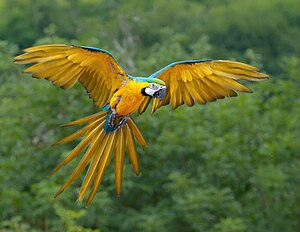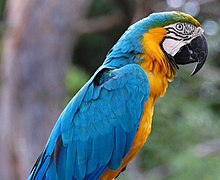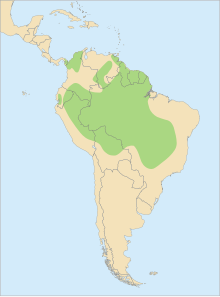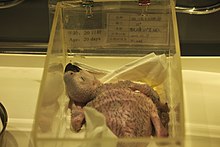Yellow and breast macaw
| Yellow and breast macaw | ||||||||||
|---|---|---|---|---|---|---|---|---|---|---|

Great Yellow Macaw in flight |
||||||||||
| Systematics | ||||||||||
|
||||||||||
| Scientific name | ||||||||||
| Ara ararauna | ||||||||||
| ( Linnaeus , 1758) |
The Gelbbrustara ( Ara ararauna ) is a parrot the genus authentics macaws ( Ara ).
features
The yellow and breasted macaw usually reaches a length of 80 to 90 cm, with a considerable part being made up of its tail feathers . Its plumage is blue on the top and golden yellow on the chest and belly. This color runs over the head to the neck in a turquoise blue. The featherless cheeks are white and have a few small, black-dashed feathers. The wax skin is pink and featherless, while the throat is black and has a black and green line to demarcate the rest of the body. The underside of the wing is green to yellowish. The parrot has a blue top of its tail and a yellowish underside of its tail. Its beak is black and its feet are dark gray.
distribution
Yellow and breasted macaws are widespread on the South American continent. They live in Brazil , with the exception of the extreme south and east, as well as in northern Paraguay , eastern Bolivia , eastern Peru , eastern Colombia , southern Venezuela , Trinidad , Guyana , Suriname , French Guiana and in the north to Panama .
As with almost all parrot species, the population of the yellow-and-breasted macaw is on the decline in some parts of its range. The main reason is the destruction of its environment by human settlers.
Habitat
The habitats of the yellow-and-breasted macaws are tropical to subtropical forests along the rivers and open semi-savannahs .
nutrition
The diet is varied and includes various fruits, nuts and berries. They particularly like to eat palm fruits from Inaja ( Maximiliana regia ) and Tucuma ( Astrocaryum ). He also regularly visits the so-called clay licks , which, according to recent research, do not serve to absorb minerals but to neutralize plant toxins .
Reproduction
The beginning of the breeding season varies from December, in the southern part of the range, to February or March in the north. The nest hole is often located in broken palm trunks up to 30 m above the ground. Caves that were created by certain insects are preferred. These are often open at the top. This can pose a great risk to the brood in very rainy years. The clutch consists of up to four eggs, but usually only one young is raised.
The yellow-and-breasted macaws always stay in pairs and form pairs, so this species can only be seen flying through the air together or often on the treetops.
Individual evidence
- ↑ Holles Tier-Enzyklopädie , 2nd edition, Andreas Verlag, Salzburg, 1972
Web links
- Ara ararauna in the endangered Red List species the IUCN 2008. Posted by: BirdLife International, 2008. Accessed on December 30 of 2008.
- Videos, photos and sound recordings of Ara ararauna in the Internet Bird Collection


